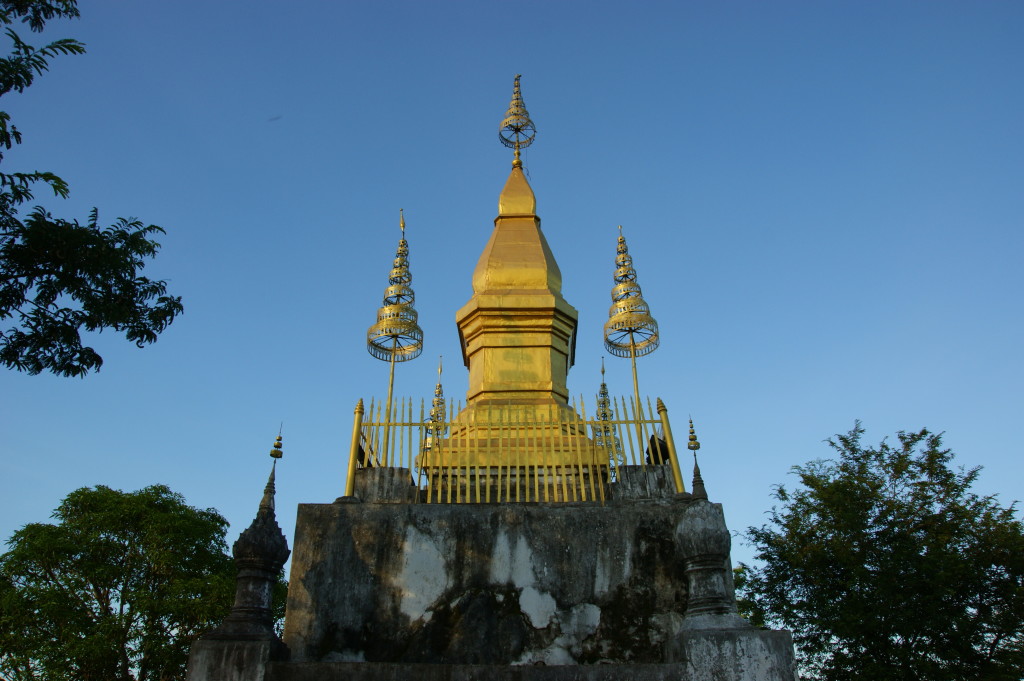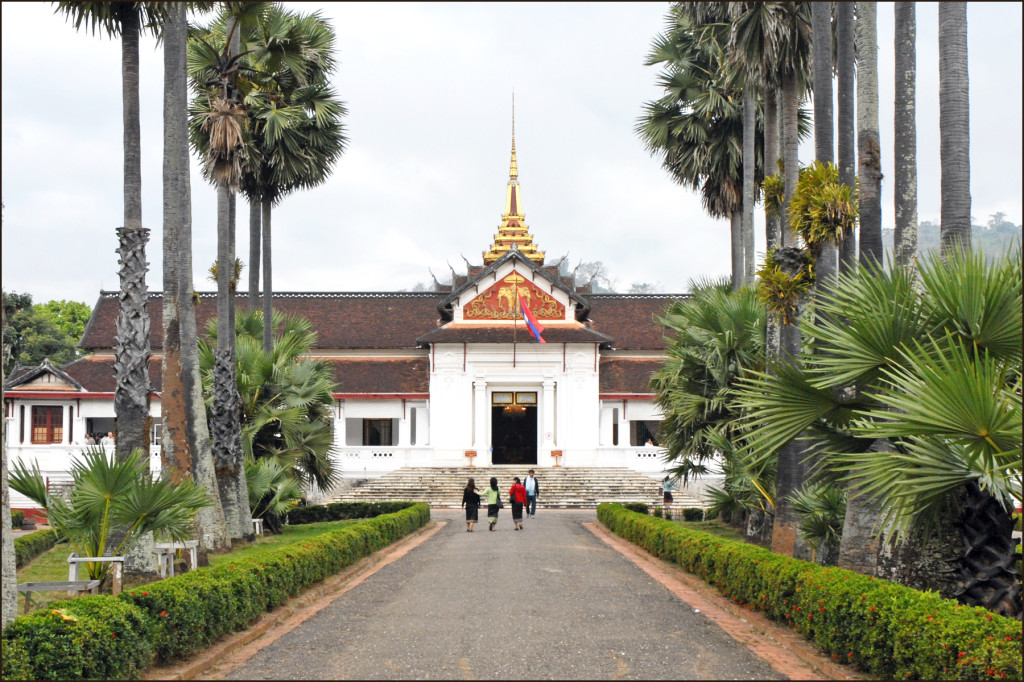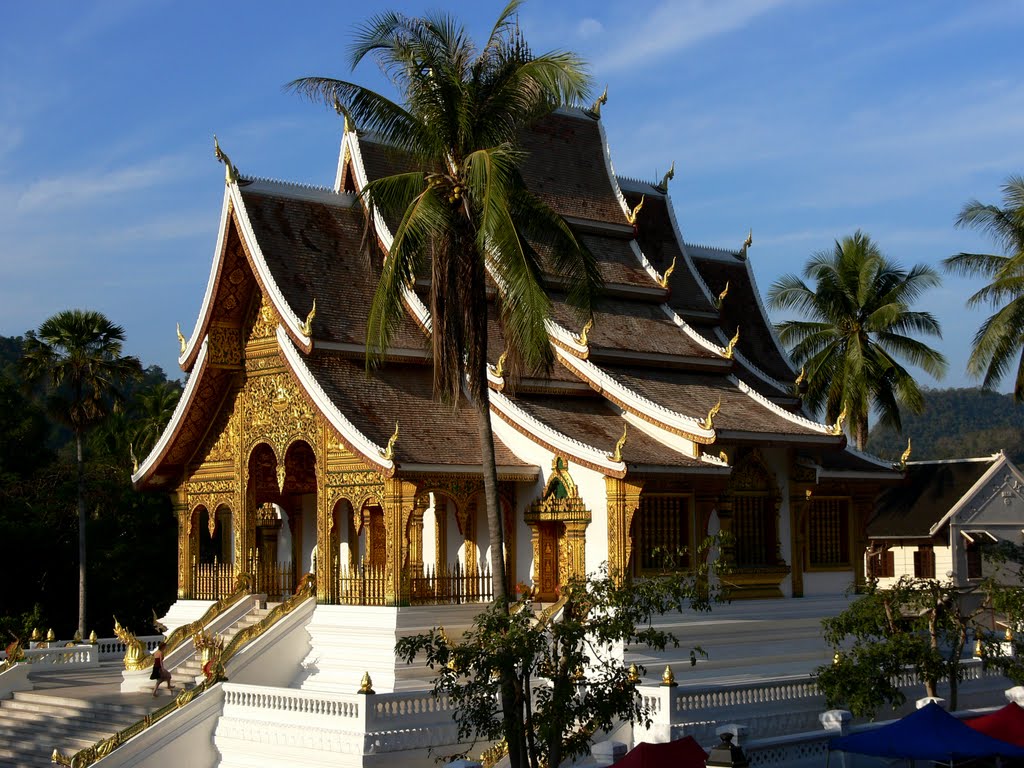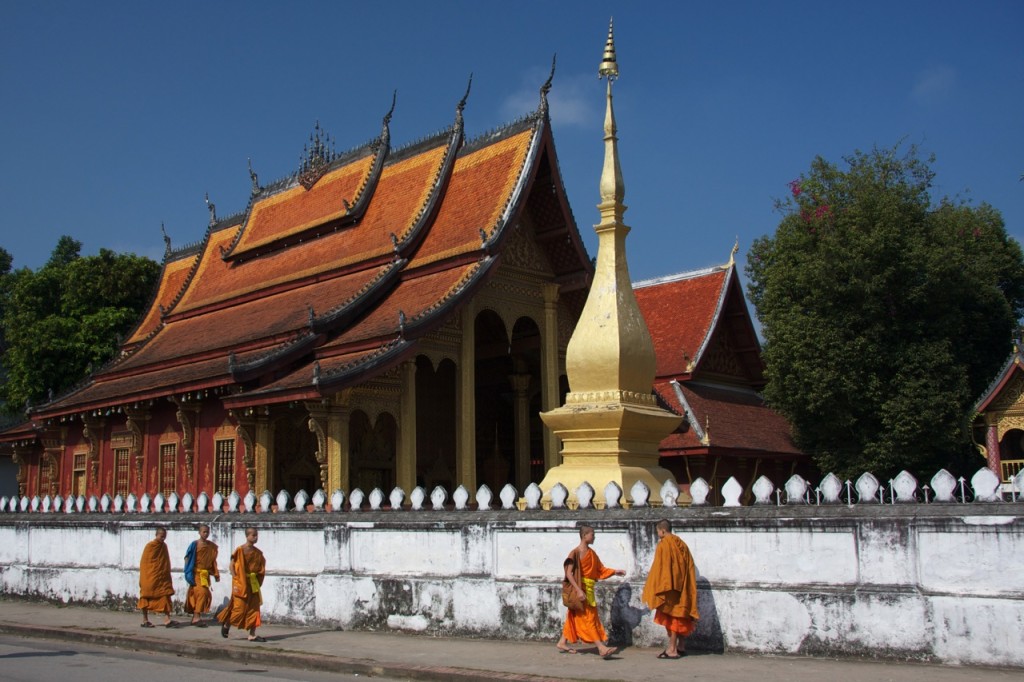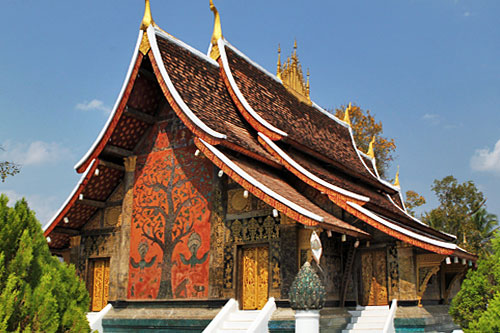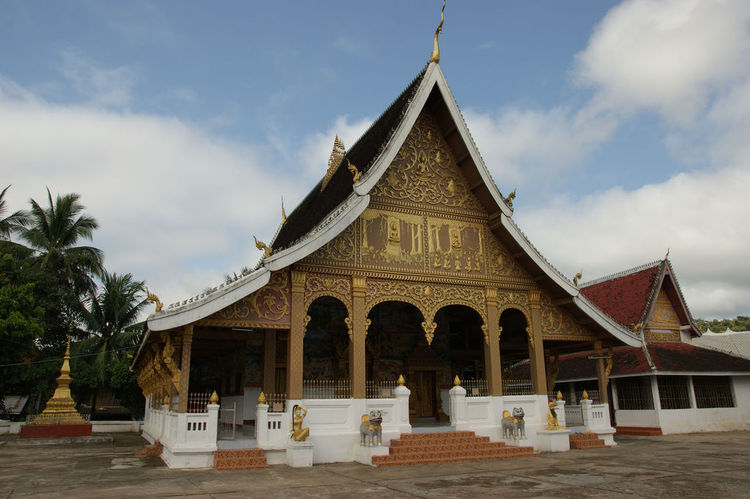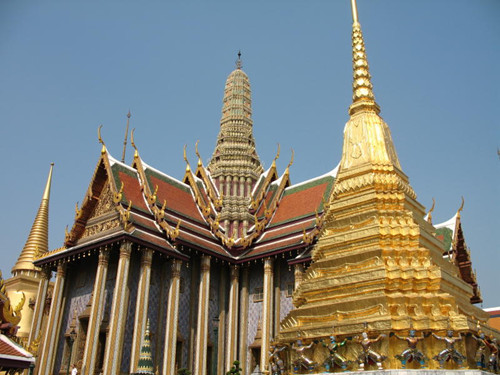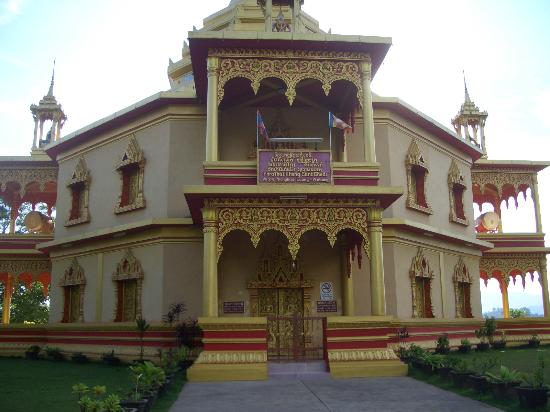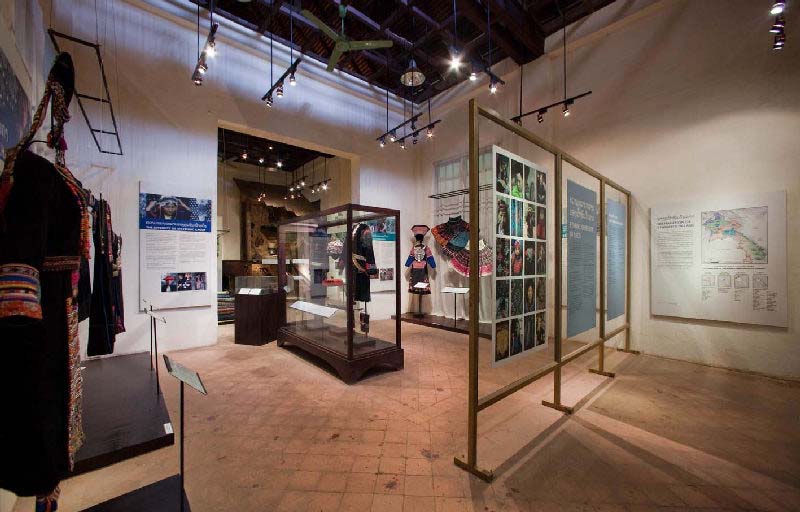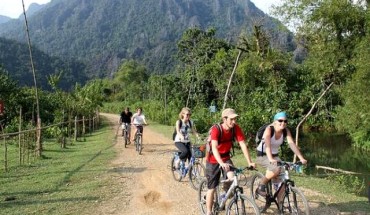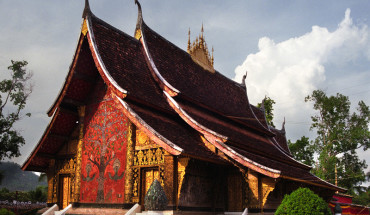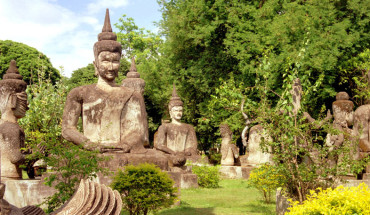The sights are conveniently close together but, to begin with, it is worth climbing Phousi or taking a stroll along the river roads to get a better idea of the layout of the town. Most of Luang Prabang‘s important wats are dotted along the main road, Phothisarath.
Mount Phousi
The western steps lead up from Sisavangvong Rd, admission at western steps. If you want to watch the sun go down, get there early and jostle for position; don’t expect to be the only person there – early morning is the time for that.
Directly opposite the Royal Palace is the start of the steep climb up Mount Phousi, the spiritual and geographical heart of the city and a popular place to come to watch the sunset over the Mekong, illuminating the hills to the east. Phousi is a gigantic rock with sheer forested sides, surmounted by a 25-m-tall chedi, That Chomsi. The chedi was constructed in 1804, restored in 1914 and is the designated starting point for the colorful Pi Mai (New Year) celebrations in April. Its shimmering gold-spired stupa rests on a rectangular base, ornamented by small metal Bodhi trees. Next to the stupa is a little sanctuary, from which the candlelit procession descends at New Year, accompanied by effigies of Nang Sang Kham, the guardian of the New Year, and Naga, protector of the city.
Royal Palace
Sisavangvong Rd, Shorts, short-sleeved shirts and strappy dresses are prohibited; shoes should be removed and bags must be put in lockers. No photography.
Also called the National Museum, the Royal Palace is right in the centre of the city on the main road and close enough to the Mekong to allow royal guests ready access by river. Unlike its former occupants, the palace survived the 1975 revolution and was converted into a museum the following year.
It was built by the French for the Lao King Sisavang Vong in 1904 in an attempt to bind him and his family more tightly into the colonial system of government. Later work saw the planting of the avenue of palms and the filling in of one of two fish ponds. Local residents regarded the ponds as the ‘eyes’ of the capital, so the blinding of one eye was taken as inviting bad fortune by leaving the city unprotected. The subsequent
civil war seemed to vindicate these fears. The palace is Khmer in style, cruciform in plan and mounted on a small platform of four tiers. The only indication of French involvement can be seen in the two French lilies represented in stucco on the entrance, beneath the symbols of Lao royalty. There are a few Lao motifs but, in many respects, the palace is more foreign than Lao: it was designed by a French architect, with steps made from Italian marble; built by masons from Vietnam; embellished by carpenters from Bangkok, and funded by the largesse of the colonial authorities.
The small ornate pavilion of Wat Ho Prabang is located in the northeast corner of the palace compound, to the right of the entrance to the Royal Palace. The chapel contains four Khmer Buddhas, ivories mounted in gold, bronze drums used in religious ceremonies and about 30 smaller Buddha images from temples all over the city. The Pra Bang, see below, is due to be moved here.
The main entrance hall of the palace was used for royal religious ceremonies, when the Supreme Patriarch of Lao Buddhism would oversee proceedings from his gold- painted lotus throne. It now contains a collection of 15th- to 17th-century Buddha statues. The room to the immediate right of the entrance was the King’s reception room, also called the Ambassadors’ Room. It contains French-made busts of the last three Lao monarchs, a model of the royal hearse (which is kept in Wat Xieng Thong) and a mural by French artist Alex de Fontereau, depicting a day in the life of Luang Prabang in the 1930s.
In comparison to the state rooms, the royal family’s private apartments are modestly decorated. They have been left virtually untouched since the day the family left for exile in Xam Neua Province. To the rear of the entrance hall, the Coronation Room was decorated between 1960 and 1970 for Crown Prince Sisavong Vatthana’s coronation, an event which was interrupted because of the war. The walls are a brilliant red with Japanese glass mosaics embedded in a red lacquer base with gilded woodwork and depict scenes from Lao festivals.
To the left of the entrance hall is the reception room of the King’s Secretary, and beyond it, the Queen’s Reception Room, which together house an eccentric miscellany of state gifts from just about every country except the UK.
To the far right of the entrance to the palace is a room (viewed from the outside) in which sits the Pra Bang, or Golden Buddha, from which the city derived its name. The Buddha is in the attitude of Abhayamudra or ‘dispelling fear’. Some believe that the original image is kept in a bank vault, though most dispel this as rumor. It is 90% solid gold. Reputed to have originally come from Ceylon, and said to date from any time between the first and ninth centuries, the statue was moved to Cambodia in the 11th century, given to King Phaya Sirichanta, and was then taken to Lane Xang by King Fa Ngum, who had spent some time in the courts of Angkor and married into Khmer royalty. An alternative story has the Pra Bang following Fa Ngum to the city: it is said he asked his father-in-law, the King of Angkor, to send a delegation of holy men to assist him in spreading the Theravada Buddhist faith in Lane Xang. The delegation arrived bringing with them the Pra Bang as a gift from the Cambodian King. The Pra Bang’s arrival heralded the capital’s change of name, from Xieng Thong to Nakhon Luang Prabang,’The city of the great Buddha’. In 1563 King Setthathirat took the statue to Lane Xang’s new capital at Vientiane. Two centuries later in 1779 the Thais captured it but it was returned to Laos in 1839. The Pra Bang is revered in Laos as its arrival marked the beginnings of Buddhism in Lane Xang.
Wat Mai
Next to the Royal Palace is Wat Mai. This royal temple, inaugurated in 1788, has a five-tiered roof and is one of the jewels of Luang Prabang. It took more than 70 years to complete. It was the home of the Buddhist leader in Laos, Phra Sangkharath, until he moved to That Luang in Vientiane. During Pi Mai (New Year), the Pra Bang is taken from the Royal Palace and installed at Wat Mai for its annual ritual cleansing, before being returned to the palace on the third day.
The facade is particularly interesting: a large golden bas-relief tells the story of Phravet (one of the last reincarnations of the Gautama or historic Buddha), with several village scenes, including depictions of wild animals, women pounding rice and people at play. Inside, the interior is an exquisite amalgam of red and gold, with supporting pillars similar to those in Wat Xieng Thong.
Wat Sene (Wat Saen)
Further up the promontory, Wat Sene was built in 1718 and was the first sim in Luang Prabang to be constructed in Thai style, with a yellow and red roof. The exterior may lack subtlety, but the interior is delicate and rather refined, painted red, with gold patterning on every conceivable surface. Sen means 100,000 and the wat was built with a local donation of 100,000 kip from someone who discovered ‘treasure’ in the Khan River.
Wat Xieng Thong
Xiengthong Road, Wat Xieng Thong Ratsavoraviharn, usually known as just Wat Xieng Thong, is set back from the road, at the top of a flight of steps leading down to the Mekong. It is arguably the finest example of a Lao monastery, with graceful, low-sweeping eaves, beautiful stone mosaics and intricate carvings. The wat has several striking chapels, including one that houses a rare bronze reclining Buddha and another sheltering a gilded wooden funeral chariot. Inside, resplendent gold-stenciled pillars support a ceiling with dharma wheels. The striking buildings in the tranquil compound are decorated in gold and post-box red, with imposing tiled roofs and mosaics, making this the most important and finest royal wat in Luang Prabang. It was built by King Setthathirat in 1559, and is one of the few buildings to have survived the successive Chinese raids that marked the end of the 19th century.
The sim is a perfect example of the Luang Prabang style. Locals believe the roof has been styled to resemble a bird, with wings stretched out to protect her young. The eight central wooden pillars have stenciled motifs in gold and the facade is finely decorated. The beautiful gold-leaf inlay is predominantly floral in design but a few images illustrate Ramayana-type themes and the interior frescoes depict dharma wheels and the enigmatic King Chantaphanit. At the rear of the sim is a mosaic representation of the thong copper Tree of Life’ in glass inlay.
Behind the sim are two red haw song phra (side chapels): the one on the left is referred to as La Chapelle Rouge (the Red Chapel) and houses a rare Lao reclining Buddha in bronze, dating from the 16th century. The exterior mosaics which relate local tales, were added in 1957 to honour the 2500th anniversary of the Buddha’s birth, death and enlightenment. The other haw song phra, to the right of the sim, houses a standing image of the Buddha which is paraded through the streets of the city each New Year and doused in water.
The Chapel of the Funeral Chariot is diagonally across from the sim and was built in 1962. The centerpiece is the grand 12-m-high gilded wooden hearse, with its seven- headed serpent, which was built for King Sisavang Vong, father of the last sovereign, and used to carry his urn to the stadium next to Wat That Luang where he was cremated in 1959. It was built on the chassis of a six-wheel truck by the sculptor, Thid Tan. On top of the carriage sit several sandalwood urns, none of which contain royal ashes. Originally the urns would have held the bodies of the deceased in a foetal position until cremation. The mosaics inside the chapel were never finished but the exterior is decorated with some almost erotic scenes from the PhalakPhalam (the local version of the Ramayana), sculpted in enormous panels of teak wood and covered with gold leaf.
Wat Visunnarat (Wat Wisunarat) and That Makmo.
This is better known as Wat Visoun and is on the south side of Mount Phousi. It is a replica of the original wooden building, constructed in 1513, which had been the oldest building in Luang Prabang, until it was destroyed by marauding Chinese tribes. The sim is virtually a museum of religious art, with numerous ‘Calling to the Rain’ Buddha statues; most are more than 400 years old and have been donated by locals. Wat Visoun also contains the largest Buddha in the city and old stelae engraved with Pali scriptures (called hin chaleuk). The big stupa, commonly known as That Makmo (‘melon stupa’), was built by Queen Visounalat in 1504. It is of Sinhalese influence with a smaller stupa at each comer, representing the four elements.
Wat Phra Maha That
Close to the Hotel Phousi on Phothisarath, this is a typical Luang Prabang wat, built in the 1500s and restored at the beginning of this century. The ornamentation of the doors and windows of the sim merit attention, with their graceful, golden figures from the Phalak phalam (the Ramayana). The pillars, ornamented with massive nagas, are also in traditional Luang Prabang style and reminiscent of certain styles adopted in Thailand.
Wat Manolom
South of Wat That Luang, Wat Manolom was built by the nobles of Luang Prabang to entomb the ashes of King Samsenthai (1373-1416) and is notable for its large armless bronze Buddha statue, one of the oldest Lao images of the Buddha, which dates back to 1372 and weighs two tons. Locals maintain that the arm was removed during a skirmish between Siamese and French forces during the latter part of the 19th century. While it is not artistically significant, the temple – or at least the site – is thought to be the oldest in the city, dating back, so it is said, to 1375 and the reign of Fa Ngum.
Wat Pa Phon Phao and Santi Chedi
3 km northeast of town, near Ban Phanom, donation expected. Outside town, Wat Pa Phon Phao is a forest meditation centre renowned for the teachings of its famous abbot, Ajahn Saisamut, one of the most popular monks in Lao history. More famous to tourists, though, is Santi Chedi, known as the Peace Pagoda. It looks as though it is made of pure gold from a distance but is rather disappointing close up. The wat was started in 1959 but was only completed in 1988; the names of donors are inscribed on pillars inside. It is modeled on the octagonal Shwedagon Pagoda in Yangon (Rangoon) and its inner walls are festooned with gaily painted frescoes of macabre allegories. Less grotesque paintings, extending right up to the fifth floor, document the life of the Buddha. On the second level, it is possible to duck through a tiny opening to admire the Blue Indra statues and the view of Luang Prabang.
Traditional Arts and Ethnology Centre
A fantastic museum dedicated to the various ethnic groups in Laos. This non-profit centre has a permanent exhibition featuring fantastic photographs, religious artifacts, clothing, household objects and handicrafts. Within the exhibition there is a focus on the Hmong and their New Year celebrations; the Khmu and their baskets and art of blackstrap looms; the Mien Yao embroidery and Lanten Taoist religious ceremonies, the Tai Dam bedding and Tai Lue culture. Truly this museum is a must-see in Luang Prabang – particularly for those that are venturing further north to go trekking. Attached to the centre is a handicraft shop that directly supports ethnic artisan communities. There’s also a cafe serving excellent Lao coffee and a small library.


